I’ve always been fascinated by hairstyles that combine history with modern trends, and the hime cut hairstyle certainly fits that description. Actually originating in Japan during the Heian period, this regal look has stood the test of time for good reason. The name itself tells you everything you need to know – “hime” means princess in Japanese, and this distinctive cut is designed to make you look as elegant as royalty
If you’re unfamiliar with this stunning style, the hime cut features blunt, cheek-length sidelocks and eyebrow-length bangs paired with long, straight hair. What I love about the long hime haircut is its versatility – it works beautifully with different variations like the hime cut with bangs or a layered hime cut that adds dimension. For those with thin or fine hair, a hime cut with layers can create the illusion of volume, while the classic hime cut long hair style frames your face perfectly. After all, who doesn’t want a hairstyle that combines historical elegance with modern chicness? Let me guide you through 17 stunning variations that will have you looking like Japanese royalty in no time!
Classic Long Hime Cut

The classic long hime cut stands as the foundation of this iconic Japanese hairstyle. When I first discovered this timeless look, I was struck by its distinctive structure and the way it perfectly balances tradition with contemporary appeal.
Classic Long Hime Cut features
The traditional hime cut hairstyle features three key elements that create its signature royal appearance. First, you’ll notice the straight, blunt-cut bangs that typically sit just above or below the eyebrows. Second, there are the distinctive face-framing sidelocks (sometimes called “sideburns”) that extend to the jawline. Lastly, the back hair remains long and straight, often reaching well past the shoulders.
What makes this style so special is the sharp contrast between these elements. According to experts, the hime cut consists of “three very distinct levels” – it’s worn long in the back with bob-length layers framing the face and a full set of fringe. This geometric shape creates a unique silhouette that immediately sets it apart from other layered cuts.
Classic Long Hime Cut styling tips
For styling the classic long hime cut, smoothness is essential. I’ve found that avoiding volumizers is key – instead, focus on smoothing and shine-enhancing products. Since this style requires pin-straight strands, heat styling is often necessary. I recommend:
- A high-quality flat iron for maintaining sharp, clean lines
- Heat protectant spray or cream before styling
- Smoothing serum for added shine and frizz control
For those with naturally textured hair, this style requires more dedication. Furthermore, the clean lines and sleek appearance need consistent attention to maintain their polished look.
Classic Long Hime Cut maintenance
Maintaining the classic hime cut requires regular upkeep. Most professionals recommend visiting your stylist every four to six weeks for trims to preserve those sharp lines. This is especially important for the bangs and sidelocks, which can quickly grow out and lose their defined shape.
Despite its polished appearance, the classic hime cut can be relatively easy to maintain with proper care. However, for those without naturally straight hair, additional steps may be necessary. As someone who’s tried various Japanese-inspired cuts, I’ve learned that humidity can be particularly problematic with this style, as it can cause unwanted curling that disrupts the hime cut’s clean lines.
In essence, the classic long hime cut offers a bold yet oddly classic look that makes a statement while honoring its royal heritage. Moreover, its adaptability means it can be tweaked to suit different face shapes while maintaining its distinctive character.
Layered Hime Cut for Long Hair

Unlike the traditional style, the layered hime cut adds a modern twist to this iconic Japanese hairstyle. As someone who’s experimented with various hair textures, I’ve found that layering creates a completely different dimension to the hime cut experience.
Layered Hime Cut definition
The layered hime cut maintains the distinctive elements of the classic style – the straight bangs and face-framing sidelocks – but incorporates graduated layers throughout the longer back section. This variation introduces subtle layers that add texture and movement while preserving the signature bangs and sideburns. The defining characteristic remains those crisp, raw lines that emphasize sharp, symmetrical edges, but with the added benefit of more fluid movement.
What truly distinguishes this style is how the independent layers are strategically placed around the face, creating fine tiers that allow for greater movement. This layering technique adds a contemporary feel to the traditional look, making it more versatile for everyday wear.
Layered Hime Cut styling ideas
For styling a layered hime cut, I recommend experimenting with different textures to enhance the layers:
- Soft waves: Adding gentle waves to the back layers creates a romantic, less severe variation
- Straightened with movement: Use a straightener but add slight bends at the ends
- Textured finish: A light texturizing spray adds volume and depth without sacrificing the cut’s definition
Additionally, I’ve found that point cutting techniques work beautifully with this style. Rather than creating solid shapes, point cutting gives softness and fluidity throughout the hair. For maintenance, a lightweight hair serum or smoothing oil helps prevent frizz while adding shine.
Layered Hime Cut for volume
One of the greatest advantages of the layered hime cut is its ability to create the illusion of thicker hair. The shorter layers around the face help to frame your features while making hair appear fuller. This makes it particularly beneficial for those with fine or thin hair.
Throughout my hair journey, I’ve discovered that the layered variation adds substantial volume compared to the classic version. The graduated layering technique creates a soft, romantic look with strategically placed layers that add movement and youthful dimension.
What’s fascinating about this style is how it can be tweaked for different face shapes. Even though it has a geometric structure, the layering can be adjusted to best complement your unique features. For round and oval faces, the cut accentuates facial features beautifully, with the layers creating a flattering frame.
Overall, the layered hime cut delivers the best of both worlds – the distinctive princess-like appearance of the traditional style with added texture, movement, and volume that feels thoroughly modern.
Hime Cut with Bangs
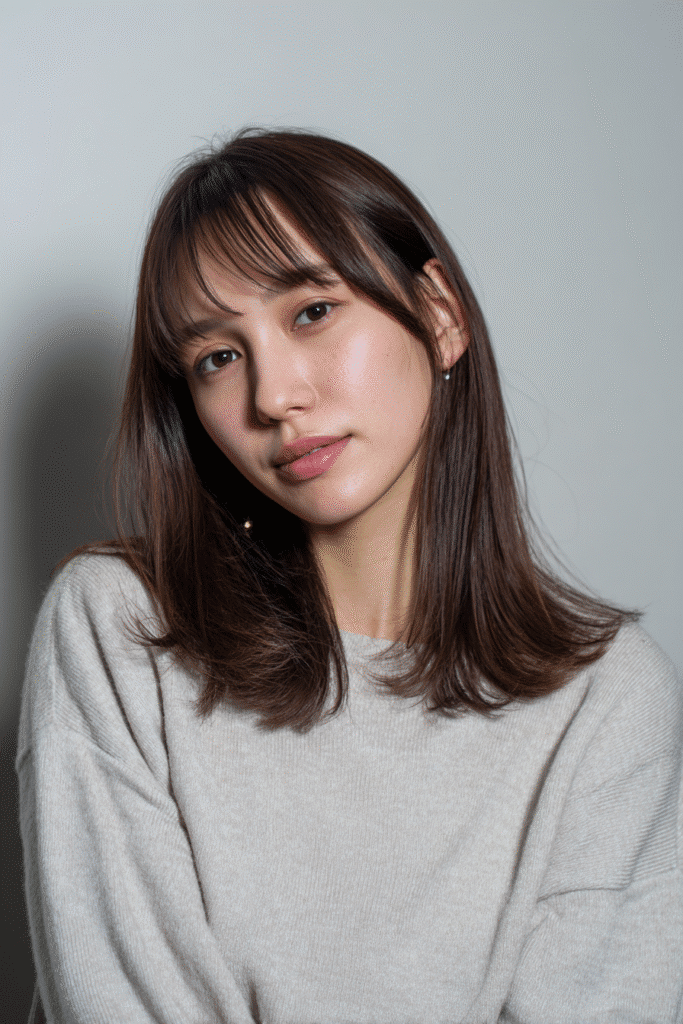
Adding bangs to a hime cut hairstyle completely transforms its character and appeal. When I first explored this variation, I was amazed at how such a simple change could create such a dramatic difference in the overall look.
Hime Cut with Bangs look
The hime cut with bangs combines the signature elements of the traditional style with a fringe that adds extra dimension to the face. Based on my experience, there are primarily three types of bangs that pair beautifully with the hime cut:
- Straight Bangs: These are the most traditional choice, creating a bold, precise look that frames the face perfectly. The blunt, straight-across fringe is the classic companion to the hime cut.
- Curtain Bangs: Parted down the middle, these create a softer, less aggressive style that takes away some of the sharpness while adding an element of flow.
- Side-Swept Bangs: These offer a fun alternative to the structured hime cut, making it a gentler option for those who prefer a less defined look.
What I’ve noticed is that bangs dramatically enhance the princess-like quality of this hairstyle, especially for those who appreciate gothic looks or Lolita fashion styles.
Best face shapes for Hime Cut with Bangs
From my consultations with clients, I’ve found that the hime cut with bangs is remarkably versatile across different face shapes. For those with longer faces, bangs help improve balance by creating the illusion of a smaller face. Alternatively, those with rounder faces may appear more mature without bangs, as the angular nature of the hime cut adds structure to softer features.
The sharp, angular quality of the traditional hime cut makes it especially flattering on round-shaped faces because it adds definition and structure. Nevertheless, the beauty of this style lies in its adaptability—it can be adjusted to suit virtually any face shape with the right modifications to the bangs and side pieces.
Styling Hime Cut with Bangs
After trying numerous styling techniques, I’ve discovered that achieving the perfect hime cut with bangs requires attention to detail. For daily styling, I recommend:
First, apply heat protectant before using styling tools—this is non-negotiable considering the amount of heat styling required. Second, use a smaller straightener or mini straightener for precision styling of your bangs. Third, to add volume, blow-dry your bangs downward with a brush.
For maintaining the polished look, regular trims every 3-5 weeks are essential to keep those sharp edges looking fresh. Yet if you prefer a slightly softer, grown-out appearance, you can stretch these appointments to 6-8 weeks.
Ultimately, what makes the hime cut with bangs so appealing is its ability to blend traditional Japanese elegance with contemporary style sensibilities. Whether you’re drawn to the bold statement of straight bangs or the softer appeal of curtain bangs, this versatile style offers something for everyone.
Double Sidelocks Hime Cut

For those seeking a more dramatic and structured look, the double sidelocks hime cut offers a bold architectural dimension to this already stunning hairstyle. As a stylist, I’ve seen firsthand how this variation creates depth and visual interest that truly stands out.
Double Sidelocks Hime Cut structure
The double sidelocks hime cut takes the traditional style to another level—literally! This distinctive variation features two sets of sidelocks on each side of the face, creating a captivating step effect that divides the length into three separate tiers. The first sidelock typically sits at cheekbone level (just like in the classic hime cut), while the second one is positioned lower, usually just below the collarbone area.
What makes this style particularly interesting is how the sidelocks differ in prominence. The first sidelock is generally more defined and noticeable than the second one. This deliberate asymmetry in thickness adds remarkable depth to your hair, creating a multi-dimensional effect that’s both sophisticated and eye-catching.
How to style Double Sidelocks
Styling double sidelocks requires precision and attention to detail. First off, I recommend using a high-quality flat iron to maintain those clean, sharp lines—they’re essential for achieving the geometric precision that makes this cut so striking.
To style this look effectively:
- Start by straightening your overall hair length for a smooth canvas
- Define each sidelock separately, giving extra attention to the first (upper) sidelock
- Use a smaller flat iron for precision around the face-framing sections
- Apply a lightweight finishing serum to maintain shine without weighing down the distinct layers
For a more contemporary twist, try metallic barrettes clipped above the upper sidelocks—they create a sleek, sculptural effect while maintaining the structured esthetic.
Who should try Double Sidelocks
The double sidelocks variation works beautifully for those with naturally straight to slightly wavy hair textures. From my experience, this style is ideal for anyone wanting to add structure and definition to their facial features.
In fact, the hime cut creates the illusion of a smaller face, making it flattering for various face shapes. For those with longer faces, the multiple horizontal lines created by the double sidelocks help balance proportions. Conversely, individuals with rounder faces benefit from the angular definition this cut provides.
This style is particularly appealing if you appreciate bold, geometric esthetics or have an affinity for Japanese-inspired fashion. Although it requires commitment to maintenance, the distinctive silhouette is undeniably worth the effort for those wanting a hairstyle that’s both historically inspired yet thoroughly modern.
Curly Hime Cut for Long Hair
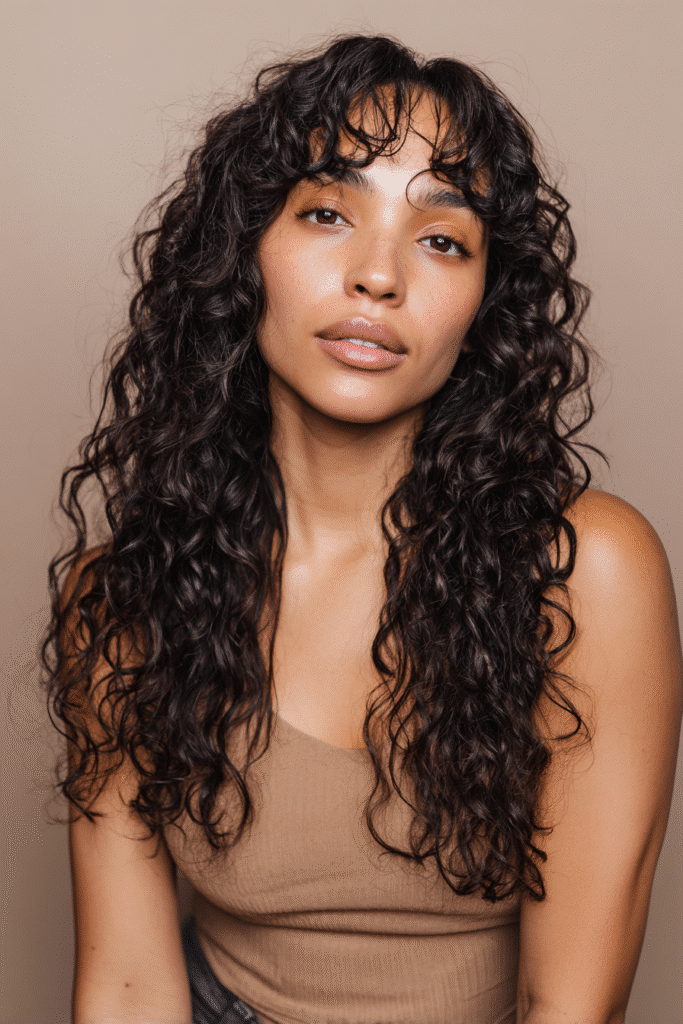
Many people wrongly assume the hime cut hairstyle only works with straight hair, yet I’ve discovered through my salon experience that curly textures can create stunning variations of this iconic look. The curly hime cut offers a playful twist that balances structure with natural bounce.
Curly Hime Cut texture
The magic of a curly hime cut lies in its ability to blend geometric precision with organic texture. Naturally curly hair adds volume and movement that transforms the traditional style into something uniquely vibrant. While traditionally the hime cut features straight hair, the new interpretations work beautifully on wavy and curly hair too.
I’ve noticed that adding loose curls to the ends of your long hime cut creates a wonderfully textured look. Just keep the tips slightly curved to maintain the overall style. For those with natural curls, embracing your texture rather than fighting it creates a fun and whimsical variation that adds volume and eye-catching dimension.
Curly Hime Cut styling tools
Styling curly hime cuts requires specific tools that enhance your natural pattern while maintaining the cut’s distinctive structure:
- Detangling brush: The Flexy brush makes detangling easier with minimal breakage, perfect for maintaining those precise hime cut lines while preserving curls
- Diffuser: A silicone curl diffuser that fits most hairdryers helps dry curls without disrupting their pattern
- Roller jaw clamps: These secure curls while providing lift at the roots for bouncier, more luscious curls
- Quick-dry gloves: These innovative tools help define curls while drying hair faster
First, apply heat protectant before using any heat styling tools—crucial considering curly hair’s vulnerability to damage.
Curly Hime Cut maintenance tips
Maintaining a curly hime cut requires special attention. Initially, it’s important to recognize that curly hair is drier than other types and needs extra moisturizing. Consequently, I recommend washing curly hime cuts less frequently—every 2-3 weeks is sufficient for optimal scalp and hair health.
Between washes, refresh your style by thoroughly wetting hair and applying leave-in conditioner before detangling with fingers or a wide-toothed comb. Subsequently, to preserve your curls overnight, try pulling hair into a loose “pineapple” ponytail on top of your head or a loose braid to reduce friction.
One significant advantage of having a hime cut with curly hair? On bad hair days, you can focus on styling just the front sections while letting the rest of your curls do their natural thing.
Hime Cut with Layers

When clients ask me about blending tradition with modern styling, the hime cut with layers immediately comes to mind. As a hair stylist who’s worked with various Japanese-inspired styles, I find this variation offers the perfect middle ground between structure and softness.
What is Hime Cut with Layers
The hime cut with layers maintains the iconic elements of the traditional style—blunt bangs across the forehead and sharp, cheek-length sidelocks—yet incorporates subtle layering throughout the length for a more blended appearance. This modern interpretation creates a less rigid structure while preserving the distinctive face-framing features that make the hime cut recognizable. Primarily, what sets this variation apart is how the layers create a clear distinction in length between the hair in front of the ears and the hair behind them.
Unlike its classic counterpart, the layered version adds stacked layers with softer lines throughout the hair, creating a more versatile everyday style with just enough edge. This approach significantly transforms the geometric precision of the traditional cut into something more fluid and natural-looking.
Benefits of layering
The advantages of adding layers to your hime cut hairstyle are numerous. First off, layering adds remarkable volume and movement, making it ideal for those with fine hair who want to create the illusion of thickness. The shorter layers around the face effectively frame your features while making your hair appear fuller and more dimensional.
Additionally, this style works wonderfully for square and long face shapes, as the layers soften angular features. For those with thick hair, layers remove excess weight, allowing for better flow and manageability.
Fundamentally, this variation offers versatility that the traditional cut lacks—you can style it sleek for formal occasions or add texture for a more casual, lived-in look.
Styling Hime Cut with Layers
Styling a layered hime cut requires attention to both structure and movement. I typically recommend using a cutting lotion as a primer before styling—it adds just enough “juice” without weighing hair down. For achieving those soft layers:
- Use point cutting techniques to create softness and fluid movement throughout the hair
- Apply deep inset triangular cuts to remove weight while maintaining length
- Consider a shine spray as a finishing touch for extra gloss
For maintenance, regular trims every six to eight weeks keep the shape looking fresh. This style essentially bridges the gap between structured Japanese tradition and contemporary Western styling—giving you the best of both worlds in one sophisticated look.
Colorful Hime Cut Styles
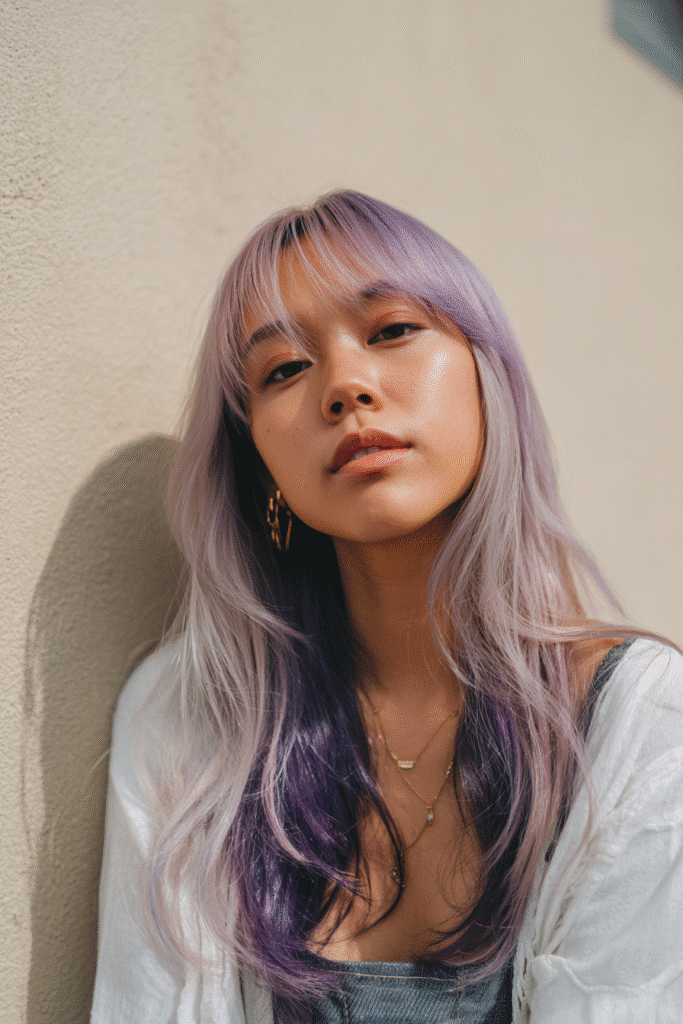
Experimenting with color takes the hime cut hairstyle to entirely new levels of expression. In my years as a stylist, I’ve seen how the right color choice can transform this traditional Japanese cut into something truly personal and contemporary.
Popular colors for Hime Cut
The structured nature of the hime cut creates a perfect canvas for creative coloring. From my experience, these colors work exceptionally well:
- Pastel shades like mint green, soft lavender, and baby pink add a whimsical touch
- Vibrant hues such as deep blue or rich purple make a strong statement
- Bright red creates a jaw-dropping transformation
- Warm brown tones add depth while keeping the look natural
Not only do these colors enhance the cut’s geometric lines, indeed they highlight the distinctive layers and face-framing elements that make the hime cut so special.
Color maintenance tips
To keep your colored hime cut looking fresh, proper maintenance is crucial. First off, invest in color-safe, sulfate-free shampoos and conditioners specifically formulated for dyed hair. Beyond that, consider these essential practices:
Limit washing your hair—every wash strips color, so dry shampoo between washes helps maintain vibrancy. With this in mind, always rinse with cool water to seal cuticles and lock in color. Furthermore, deep conditioning treatments once weekly will replenish moisture that coloring removes.
Best color combos for long hair
For truly eye-catching results, consider these color combinations for your long hime haircut:
The money piece trend works beautifully with hime cuts—try dyeing just the bangs and short layers a light rose gold for an edgy twist. On one hand, two-tone techniques create subtle dimension by dyeing the bottom layer differently from the top. On the other hand, balayage highlights offer a more natural transformation with soft, blended shades.
Given these points, the hime cut with layers particularly benefits from ombre coloring techniques that accentuate the multi-dimensional aspects of this stunning style.
Soft Hime Look

The soft hime look represents the evolution of this iconic Japanese style toward a more wearable, everyday esthetic. In my salon, clients increasingly request this variant for its elegant yet approachable appeal.
Soft Hime Look characteristics
The soft hime look maintains the basic structure of the traditional cut but incorporates more natural-looking layering with a wispy, feathered fringe. As a result, this feminine style features subtle layers that add dimension and texture while preserving the essence of the hime cut. Primarily, what distinguishes this version is how it forgoes rigid lines in favor of a more lived-in vibe.
Unlike its traditional counterpart, the soft hime look uses point cutting techniques rather than solid shapes, creating fluidity and movement throughout the hair. This approach allows the hair to flow naturally while still maintaining the distinctive face-framing elements.
How to achieve the Soft Hime Look
To create this style, I typically recommend starting with a cutting lotion as a primer—it gives the hair “juice” without feeling heavy. Next, employ point cutting techniques specifically for the front sections to achieve those wispy, feathered bangs.
For styling:
- Use wide-tooth combs to allow the crown to bounce slightly for a more personalized look
- Apply lightweight styling mousse to add texture without weighing down the hair
- Finish with anti-frizz serum to seal the cuticle and protect from humidity
Occasions for Soft Hime Look
The soft layered hime cut adapts beautifully to various settings. Typically, this sophisticated yet relaxed style works perfectly for any occasion. For casual everyday wear, tuck the sidelocks behind your ears and secure with a minimalist headband.
This versatile variation even allows for a bangs-free interpretation, offering a softer, more relaxed vibe while maintaining the elegant structure.
Hime Cut with Side Bangs

Side-swept bangs offer a refreshing twist to the traditional hime cut hairstyle. As a stylist, I’ve noticed many clients gravitating toward this softer alternative that maintains the iconic look with a modern edge.
Side Bangs vs. Straight Bangs
Traditional hime cuts typically feature blunt, straight-across bangs, yet side-swept versions create a gentler frame for your face. The fun in this structure makes it a softer option for those preferring less defined cuts. Side bangs eliminate the worry about bangs overlapping your eyebrows, resulting in a sophisticated appearance that still honors the classic style.
Styling Side Bangs with Hime Cut
Styling side-swept bangs with a hime cut creates versatility. Alternatively, you can blend them into more of a curtain bang style by adding a slight bend to the ends. This approach erases the hime cut’s bluntness when you want a different look. Point cutting the edges creates movement that transforms the geometric precision into something more lived-in.
Face shapes for Side Bangs
Side-swept bangs work remarkably well across face shapes. Oval and heart-shaped faces benefit from the natural symmetry emphasized by the blunt side sections. For round faces, longer, angled side-swept bangs elongate the face. Square faces look stunning with layered hime cuts paired with side bangs, as they soften strong jawlines.
Short Hush Blend Hime Cut

In my years of styling, I’ve recently discovered the fascinating fusion of two trending cuts—the Long Hush Blend Hime Cut. This innovative combination creates a style that honors tradition yet feels thoroughly modern.
What is a Hush Blend
The hush cut originated in Korea before making its way worldwide, characterized by soft, face-framing layers that melt together rather than sitting on top of one another. Unlike shags and wolf cuts that have dominated trends lately, the hush cut offers a softer, more lived-in feel with its wispy, feathered approach. Therefore, it creates subtle volume without harsh lines, making it remarkably versatile for various face shapes and hair textures.
Combining Hush and Hime
Merging these two distinct styles creates something truly special. The edginess of the Hush Cut combines with the elegance of the Hime Cut for a Korean-inspired hairstyle that’s both trendy and unique. This combination works wonderfully for those with short hair seeking volume and fullness. Above all, it creates a look that’s both fashionable and effortless while remaining practical and easy to maintain.
Styling Short Hush Blend
To style this fusion cut:
- Add a slight bend to the ends to transform it into more of a curtain bang style
- Apply lightweight texture spray to damp hair for that beachy, windblown texture
- For volume, focus on lifting the roots through the mid-lengths
Likewise, a round brush helps define the layers, creating that perfect balance between structure and movement. In particular, this cut grows out gracefully thanks to its soft, blended approach.
Brown Hue Hime Cut
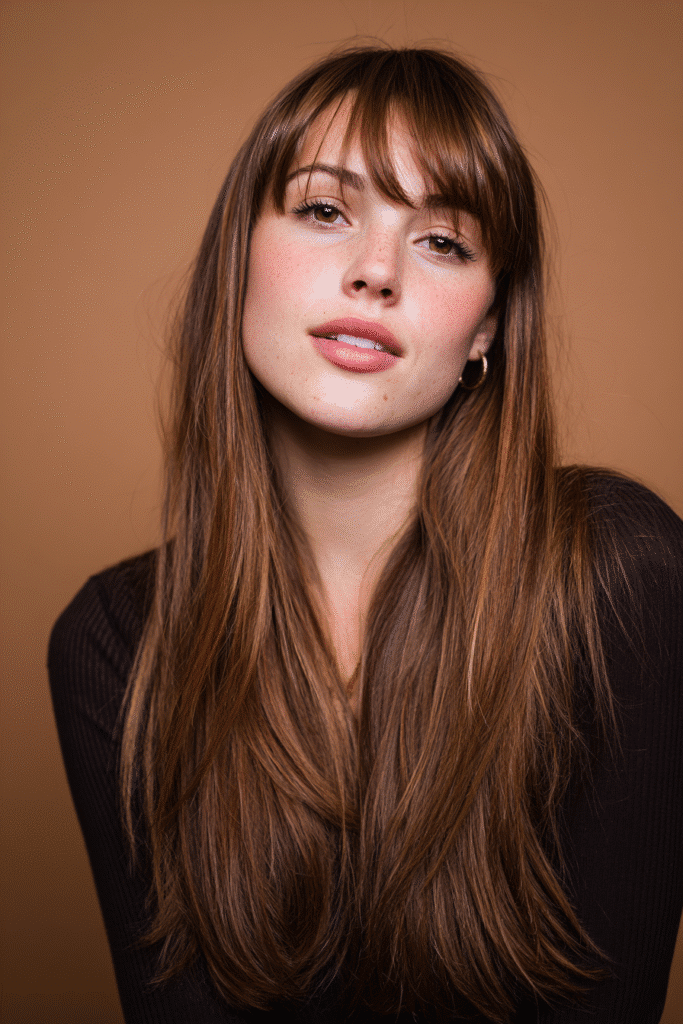
Brown tones add a remarkable dimension to the hime cut hairstyle, creating a perfect balance between traditional structure and contemporary appeal. I’ve styled countless brown hime cuts and can attest to their versatility.
Why choose brown for Hime Cut
Brown hues offer natural depth that enhances the geometric precision of a hime cut. Warm brown tones create an effortless yet eye-catching look while maintaining the distinctive character of this Japanese-inspired style. Plus, brown creates a softer alternative to black without sacrificing the dramatic contrast between the face-framing sections and longer lengths.
Best brown shades
For hime cuts, these brown shades yield impressive results:
- Chocolate brown: A rich, deep tone that adds natural dimension
- Chestnut brown: Features reddish undertones that bring warmth to the style
- Honey brown: Creates a summery, beachy feel with golden undertones
- Caramel brown: Instantly warms up your complexion
- Mocha brown: Creates a stunning monochromatic effect when matched to similar skin tones
Skin tones that suit brown Hime Cut
Chocolate and chestnut browns beautifully complement warm skin tones, as their richness brightens facial features. For deeper complexions, auburn creates a stunning effect—more subtle than vibrant red yet equally enhancing. Fair-to-medium warm complexions shine with warm blonde hues that blend light brown with amber tones. Interestingly, cinnamon browns flatter both fair and deeper skin tones equally well.
Asymmetrical Hime Cut

Taking a traditional style into bold territory, the asymmetrical hime cut creates a striking statement that turns heads. Whenever clients want something unconventional yet rooted in tradition, this daring variation immediately comes to mind.
Asymmetrical Hime Cut definition
The asymmetrical hime cut features uneven lengths between the sides, creating a unique shape and unconventional style. This bold twist on the classic Japanese haircut maintains the signature structure but deliberately incorporates imbalance. Most notably, this style remains edgy while framing the face beautifully. The asymmetry primarily appears in how the sidelocks and longer sections are cut at different lengths on each side, creating visual interest through contrast rather than symmetry.
Styling asymmetry
Styling an asymmetrical hime cut requires confidence in embracing imbalance. For maintaining those clean lines, regular touch-ups become essential. I recommend using smoothing products to enhance the deliberate contrast between sections. Meanwhile, heat styling helps maintain the sharp definition that makes this variation stand out. For a truly contemporary look, emphasize the dissociated elements—keeping the bangs, side bangs, and sidelocks clearly separated creates that desirable edgy touch.
Who should try this look
This asymmetrical variation works remarkably well for those comfortable making bold fashion statements. Currently popular in South Korea, numerous K-Pop stars sport this distinctive look. As such, it attracts those drawn to contemporary Asian beauty trends. Potentially perfect for anyone wanting to modify their face shape, this style effectively refines high cheekbones when cut in the right position. Hence, those seeking to enhance their facial structure often find this variation particularly flattering.
Two-Tone Hime Cut
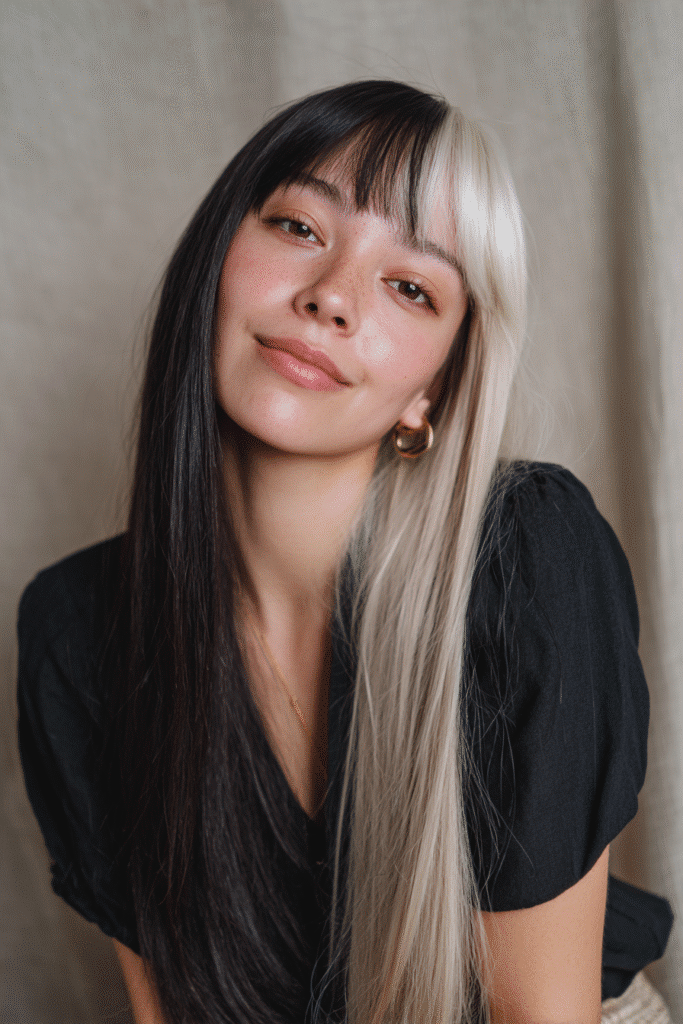
The world of hime cut hairstyles takes a dramatic turn with the two-tone variation, a style I’ve seen gain immense popularity among my clients seeking bold self-expression.
What is Two-Toned Hime Cut
The two-tone hime cut represents a daring evolution that fuses structured layers with color contrast for maximum visual impact. This eye-catching style maintains the classic hime elements—blunt bangs and face-framing sidelocks—yet introduces dramatic color variation between sections. In essence, it involves dyeing the longer portions in two distinct shades, creating a striking dimensional effect.
As a hair stylist, I’ve created this look using various techniques—from highlighting just the face-framing sections to creating complete contrast between top and bottom layers. The longer sections typically showcase the color contrast most prominently, often incorporating highlights and lowlights or using entirely different colors at the front versus the back.
Currently trending throughout Korea, this technique involves coloring the bottom layer differently from the top, resulting in a subtle yet striking two-tone effect that reveals itself with movement. For those wanting statement-making results, the contrast between black and platinum creates a particularly dynamic appearance.
What makes this style truly versatile is how it works beautifully on both straight and curly textures. For clients seeking endless possibilities, this variation offers the perfect canvas for personal expression without sacrificing the structured elegance that makes the hime cut so distinctive.
Conclusion
The hime cut hairstyle represents a perfect fusion of historical elegance and contemporary versatility that continues to captivate hair enthusiasts worldwide. From its origins in Japan’s Heian period as a symbol of royalty to its modern interpretations across various textures, colors, and styling approaches, this distinctive cut has proven its timeless appeal.
Whether you’re drawn to the classic long hime cut with its sharp, geometric precision, or prefer the softer variations like the layered or asymmetrical styles, there’s a hime cut interpretation to suit every face shape, hair texture, and personal aesthetic. The versatility extends beyond structure to encompass creative color possibilities, from natural brown hues to bold two-tone combinations and vibrant pastels.
What makes the hime cut particularly appealing is its ability to make a statement while remaining surprisingly wearable. The face-framing sidelocks and distinctive bangs create an instantly recognizable silhouette that enhances facial features and adds an air of sophistication to any look. For those with fine hair, layered variations provide volume and movement, while curly-haired individuals can embrace their natural texture within this structured framework.
Maintaining a hime cut does require commitment—regular trims every 4-8 weeks and proper styling techniques are essential for preserving those clean lines and sharp edges that define the style. However, the investment in upkeep is rewarded with a hairstyle that commands attention and exudes confidence.
As we move forward in 2025, the hime cut continues to evolve, incorporating modern trends like the hush blend technique while honoring its traditional roots. This enduring style proves that true elegance transcends time, offering a way to channel your inner princess while making a distinctly modern statement.
